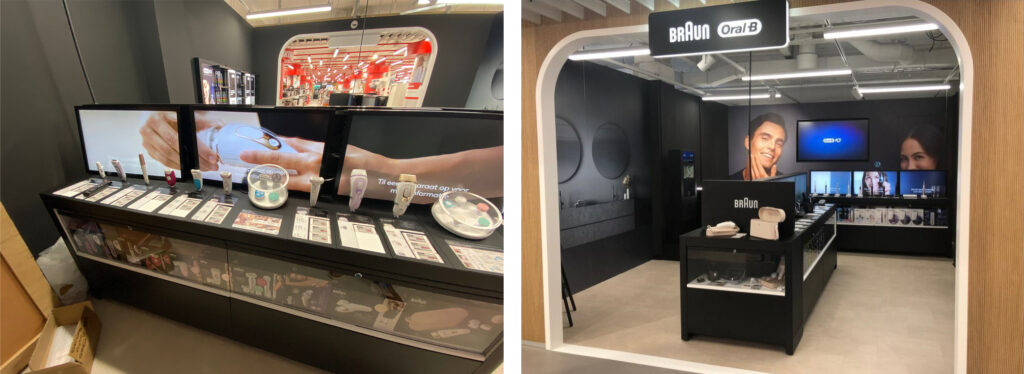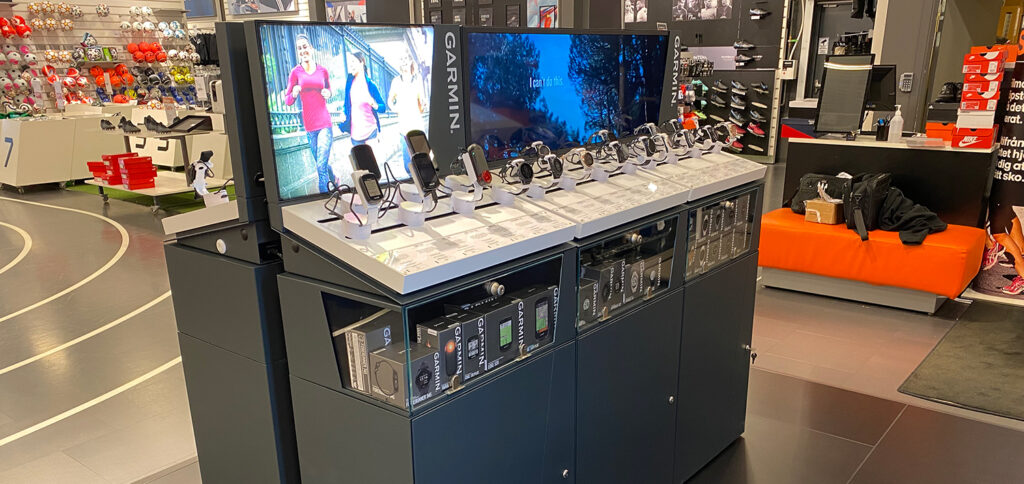trends, retail experiences, design, innovation, insights
Welcome to the new era for ‘shop in shop’ ventures
Shop-in-shop or ‘retail concessions’ are not a new concept. It was department stores that kicked off the business model a staggering 150 years ago thanks to an inspired Parisian called Aristide Boucicaut.
In the last few years though, we’ve seen the closures of department stores worldwide and a shift to seeing concessions in new and sometimes surprising places. In hindsight though, where we’re seeing these new concessions and what those concessions are – make absolute sense.
It’s been a number of years that we’ve had Costa coffee shops in Tesco stores and M&S stores, Habitat in Sainsbury’s, and Starbucks in several retailers including Amazon Go stores. The latest that consumers might delight in is Holland & Barratt and The Entertainer toys in Tesco stores, Paperchase in Next stores, or more notably ‘Garden by Homebase’ in select Next stores. (Side note, Next’s retail business strategy is captivating, and we’ll be writing about this in the coming months)
Across the pond, brick-and-mortar Toys “R” Us stores are back, with Macy’s announcing the opening of stores in 9 US states, with another due to open in a further 19 states before the holiday 2022 shopping season.
There is a lot of change afoot, and whatever each parent retailer’s shop-in-shop’ strategy, one can only assume that the relevant departments are due to have a busy few years ahead. It seems every day there’s something new to digest in this space.
So, what is happening?
The most obvious place to start is the pandemic. Significant shifts happened during this time and digital progress took great leaps forward: Online purchasing skyrocketed with PWC reporting that 16% of consumers now say they intend to purchase more online (1), and people were suddenly accepting of online education, concerts, and socialising.
Although online sales have jumped the previous trajectory of online shopping, there is still a need for a physical destination. Having a destination offers advantages that online shopping cannot: In person expertise from staff, product sampling, brand immersion, and a sense of community.
According to Trendwatching bricks and mortar retail will still have a firm place in consumers’ thoughts and behaviour as they look to reclaim their local and maintain a State of place. 53% of people polled were more interested in shopping locally than before the pandemic (2). And ‘near me’ shopping searches remain popular. Additionally, they say brands that look to make those ‘local’ spaces better will hold a particular affection in the minds of consumers.
Responding to these shifting behaviours, supermarkets and retailers like Next have searched for ways to re-establish the pull of the destination, enhancing the in-store shopping experience for customers, and encouraging dwell time.
As we now face more economic uncertainty, consumer behaviour is set to take another dramatic shift. Particularly in the UK, we can expect to see people cutting back on spending, trading down, and shopping around for better deals. This lack of loyalty will naturally affect both brands and retailers. Therefore, placing oneself firmly on the destination map and placing consumers at the heart of the retail offering, and catering to their needs has never been more important.
So how do you maintain your brand essence when you’re in someone else’s space?
Besides the destination, the intricacies of concessions are unlikely to have changed much. However, this is a relatively new play for some parent stores, and for the brands, this is a new partner also. Although this is a win-win for both parties, as with any new joint venture there are intricacies that will need close monitoring. Particularly when it comes to maintaining your brand essence in what may be a complex space.
To ensure the brand essence of both parties is upheld and respected, solutions for providing great brand experiences within parent shops are as dynamic as one would expect. Finding a display partner who is capable of supporting the shop-in-shop relationship and its intricacies is vital. At Displayplan we believe that flexibility, a detailed understanding of both parent and concession shops, scalable end-to-end solution focus, and a deep understanding of consumers, are the backbone of any good shop-in-shop relationship.
Let us talk you through a couple of examples:
Braun Lighthouse Boutique Media World, Rotterdam

Braun products are sold in a variety of different parent stores, from pharmacists to electronics specialists. Creating brand destinations and helping shoppers engage with the full Braun range completely separate from any influence from the wider category is key. In this Braun ‘lighthouse boutique’ at Media World (MediaMarkt) in Rotterdam post build 100% of Braun and Oral B products were demo-ready and shoppable where previously only 50% of the range was on the shelf.
As with all retail builds, the parent stores’ requirements and store layout must be respected, and this can sometimes mean thinking outside the box and working within a physical environment that is not traditionally considered ‘on brand’ for Braun. Here we designed the perfect blend of brand and product experience with product stock instantly available thanks to clever hidden storage.
Drawing on years of experience in understanding both the brand and the parent store ensures we have the ability to provide the design vision as well as deliver an engaging, and impactful digitally supported interactive experience. With this new design, a sales associate was given a discreet partition to work within and was therefore available to provide shopper assistance with comparison and selection. With this particular case our client was delighted with their sales uplift goals.
Garmin concession, Stadium, Malmo, Sweden

We work with Garmin market teams across Europe to deliver Garmin retail experiences that are inside different types of sport retailers from generalists to specialists like bicycle stores.
Placing Garmin inside a parent store we have to understand the retailer’s brand and physical requirements, as well as local health and safety regulations. We create a complete design layout for approval by both Garmin and the retailer, ensuring the right hierarchy of messaging is complete, and products are presented in a way that best allows shoppers to test and trial the Garmin products in that store.
Stadium stores in Sweden are all unique in size and floor space, and the placement of Garmin’s concession was often unknown. Therefore, a number of aspects were critical to success: displays needed to be modular and fit within the slat wall systems of Stadium stores, they needed to be flexible enough to fit wherever they were positioned. Equally displays needed to be eye-catching and incorporate digital elements, accessory-specific zones were needed, and lastly, consumers needed to walk away with absolute clarity on how these products could potentially impact their sporting life. As always Garmin’s product needed to be the hero, and the space needed to be owned in a very Garmin specific way.
In conclusion
Overall, the new breed of parent stores we are seeing is a win-win for brands and retailers alike. Partnering with recognisable brands and retailers gives parent retailers benefits not only from rented out floor space, but also offers a new way to engage with potentially a different audience.
The concession of course benefits from a captive audience and increased footfall placing their product in front of potentially a greater audience than they might find on the high street.
As ever though, it’s the consumers’ needs that should be at the heart of what both the parent shop and concession does. According to Simon Quirk of Kantar – “the key to a good concession strategy is to really understand your shopper demographic and the nuances of your local catchment area – who is coming through your doors, what are their spending priorities and where else do they regularly shop”
Whatever it is consumers are looking for it is our job to provide this for them, so paying close attention to not only accelerating consumer trends but also keeping an eye on wider macro factors will prepare us for the next event; be that a financial downturn, supply chain issues or another pandemic.
(1) Where next for retail – Strategy&, PWC
(2) Trendwatching report 2022
